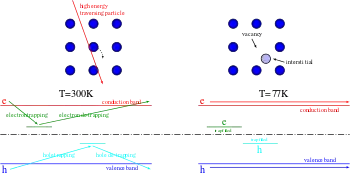
The Lazarus effect refers to semiconductor detectors; when these are used in harsh radiation environments, defects begin to appear in the semiconductor crystal lattice as atoms become displaced because of the interaction with the high-energy traversing particles. These defects, in the form of both lattice vacancies and atoms at interstitial sites, have the effect of temporarily trapping the electrons and holes which are created when ionizing particles pass through the detector. Since it is these electrons and holes drifting in an electric field which produce a signal that announces the passage of a particle, when large amounts of defects are produced, the detector signal can be strongly reduced leading to an unusable (dead) detector.
However in 1997, Vittorio Giulio Palmieri, Kurt Borer, Stefan Janos, Cinzia Da Viá and Luca Casagrande at the University of Bern (Switzerland) found out that at temperatures below 130 kelvins (about −143 degrees Celsius), dead detectors apparently come back to life.[1] The explanation of this phenomenon, known as the Lazarus effect, is related to the dynamics of the induced defects in the semiconductor bulk.
At room temperature radiation damage induced defects temporarily trap electrons and holes resulting from ionization, which are then emitted back to the conduction band or valence band in a time that is typically longer than the read-out time of the connected electronics. Consequently the measured signal is smaller than it should be. This leads to low signal-to-noise ratios that in turn can prevent the detection of the traversing particle. At cryogenic temperatures, however, once an electron or hole, resulting from ionization or from detector leakage current, is trapped in a local defect, it remains trapped for a long time due to the very low thermal energy of the lattice. This leads to a large fraction of 'traps' becoming filled and therefore inactive. Trapping of electrons and holes generated by particles traversing the detector is then prevented and little or no signal is lost. The understanding of this has been detailed in a number of papers.[2][3][4]
Thanks to the Lazarus effect, silicon detectors have been proven to be able survive radiation doses in excess of 90 GRad[5] and they have been proposed for future high luminosity experiments.[6]
References
- ↑ Vittorio Giulio Palmieri; Kurt Borer; Stefan Janos; Cinzia Da Viá; Luca Casagrande (1998), "Evidence for charge collection efficiency recovery in heavily irradiated silicon detectors operated at cryogenic temperatures", Nuclear Instruments and Methods in Physics Research Section A: Accelerators, Spectrometers, Detectors and Associated Equipment, vol. 413, no. 2–3, pp. 475–478, Bibcode:1998NIMPA.413..475P, doi:10.1016/S0168-9002(98)00673-1
- ↑ K. Borer et al.: Charge collection efficiency of irradiated silicon detector operated at cryogenic temperatures. In: Nuclear Instruments and Methods in Physics Research A. 440, 2000, S. 5–16, doi:10.1016/S0168-9002(99)00799-8
- ↑ V. Granata et al.: Cryogenic technology for tracking detectors. In: Nuclear Instruments and Methods in Physics Research A. 461, 2001, S. 197–199, doi:10.1016/S0168-9002(00)01205-5
- ↑ K. Borer et al.: Charge collection efficiency of an irradiated cryogenic double-p silicon detector. In: Nuclear Instruments and Methods in Physics Research A. 462, 2001, S. 474–483, doi:10.1016/S0168-9002(01)00198-X
- ↑ Casagrande et al.: A new ultra radiation hard cryogenic silicon tracker for heavy ion beams In: Nuclear Instruments and Methods in Physics Research A. 478, 2002, S. 325-329, doi:10.1016/S0168-9002(01)01819-8
- ↑ Zhang Li et al.: Cryogenic Si detectors for ultra radiation hardness in SLHC environment. In: Nuclear Instruments and Methods in Physics Research A. 579, 2007, S. 775–781, doi:10.1016/j.nima.2007.05.296
Further reading
- Back from the dead In: New Scientist 17 October 1998 (Online)
- Raising the dead detectors In: CERN Courier 29 March 1999 (Online)
- Radiation hard silicon detectors lead the way In: CERN Courier 1 January 2003 (Online).
- Ursula Hennigfeld (ed.): Lazarus - Kulturgeschichte einer Metapher. Heidelberg: Winter 2016.